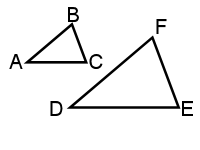Introduction to Similar Triangles
Reference > Mathematics > Geometry > Similar TrianglesSimilarity of triangles is a bit like congruence. We say that two triangles are congruent if they have the same shape and the same size. Two triangles are similar if they have the shape, but they don't have to have the same size.
To understand this, picture a "yield" sign. It's an equilateral triangle. We could call it triangle ABC. Suppose a child had a model of a highway, with a miniature yield sign. (Let's call that triangle XYZ!) Even though triangle XYZ is much smaller than triangle ABC, we can say they are the same "shape" because they are both equilateral triangles. So even though they aren't the same size, we say they are similar. The way we write this is:
XYZ ~ ABC.
This is somewhat like a "congruence" symbol, but it's missing the "equality" symbol under the wavy line. That makes sense, because when you talk about congruent triangles, you are saying that the corresponding sides' measures are equal but we're not making that claim when we say that two triangles are similar!
So how can we tell if two triangles are similar?
It's pretty simple; if all their pairs of corresponding angles are equal in measure, then the two triangles are similar.
Take the diagram below as an example:

If I told you that
It turns out, all we really need is to know that two pairs of angles are the same, and from that we'll know that the third pair is the same.
Suppose that triangle ABC is isosceles with two similarity statements for these:
ABC ~ KLJ, and ABC ~ LKJ.
It makes sense, doesn't it? A could correspond to K, but it could also correspond to L, because they're both the same!
I wonder how many similarity statements we could write for those yield signs we talked about earlier...
Questions
 Unit Index
Unit Index Sides of Similar Triangles
Sides of Similar Triangles

